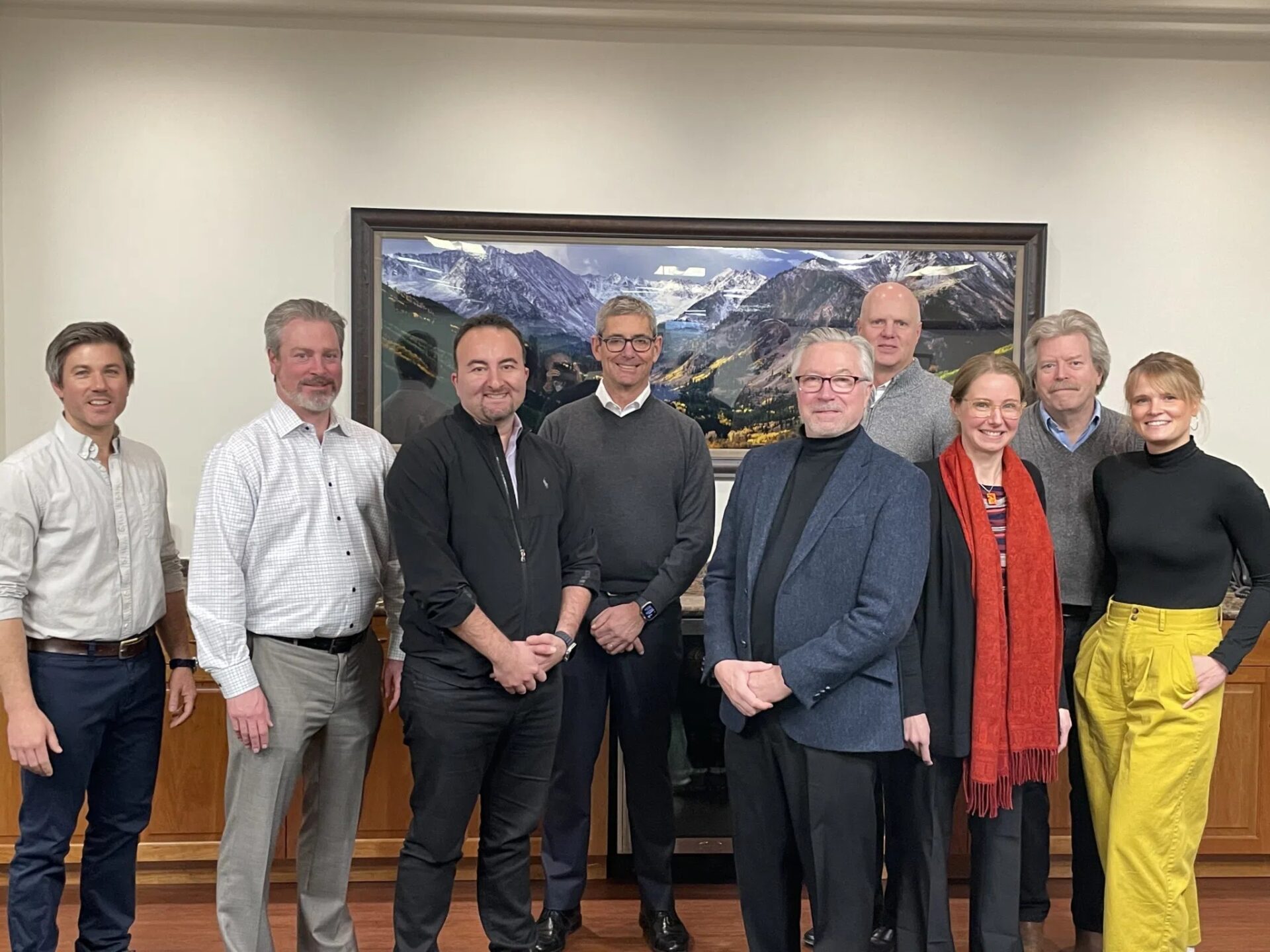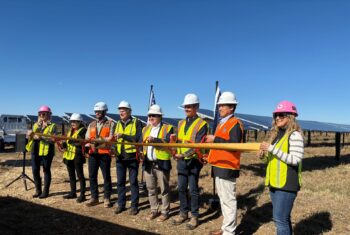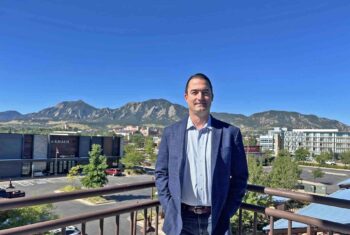CEO Roundtable: Climate warming for clean tech, execs say

Attending the CEO Roundtable on Climate Tech were Caleb Tristan, CO-Z; Aaron Spear, Bank of Colorado; Jacques Nader, Siemens Power Generation; Michael Rucker, Scout Clean Energy; Loren Burnett, Prometheus Materials; Jim Cowgill, Plante Moran; Alexandra Holland, PIARCS PBC; Carl Lawrence, EnergySense; and Ashley Cawthorn, Berg Hill Greenleaf Ruscitti. Not pictured is Ian Dickinson, LongPath Technologies, who joined via Zoom.
BOULDER — Industry and consumers are warming to the need for clean technology and reducing their carbon footprints, executives in the industry say, and federal legislation
such as infrastructure bills and provisions of the Inflation Reduction Act have made the road ahead much smoother.
“The IRA is a game changer,” Michael Rucker, CEO of Scout Clean Energy, said Tuesday during BizWest’s CEO Roundtable in Boulder. “Development in this industry traditionally has gone in cycles based on extension of tax credits. It was extremely diffcult for manufacturers to get capital for equipment when they were working with one-year extensions. It was extremely risky in that kind of environment. But the IRA has given us at least a 10-year window to plan.
“That’s a huge change for us,” he said.
Scout works on utility-scale wind and solar power storage, and Rucker said “we can’t hire people fast enough to support the growth we’re seeing. People who have been in the industry and have experience are hard to find, so we’re trying to train in-house.”
The IRA has provided “a lot of incentives right now to invest,” added Jacques Nader, director of Siemens Power Generation, “but on the flip side, I’m not sure supply and workforce are ready.” He noted that his biggest challenges are “workforce availability and supply-chain security.”
“A lot of the tax credits have been beneficial,” said Caleb Tristan, whose company, CO-Z, specializes in products, services and energy storage directly targeted to reducing global warming. He said he’s seeing more investors and clients, with a tone, culture and requests for proposals “that are more geared toward our type of company.”
Loren Burnett, president and CEO of Prometheus Materials, which is using algae to create a zero-carbon alternative to concrete, recalled that a decade ago, “you could raise enough money to kind of get going, but when you needed to raise some serious capital, $10 million or so, it was virtually impossible to do. Investors would rather put their money towards a software company where they could put in less money and get a return in two or three years.
“This is an entirely different time now,” he said. “The money is absolutely available, there are a lot of funds that didn’t exist before, and new ones almost all the time.”
Burnett founded six startup companies, he said. “The first five years, you had to work like heck to get a sale. With this company, I’m literally telling customers to hold on, we’re not quite ready yet, and we’ll get back to you as soon as we are.”
The Inflation Reduction Act “was really as much an energy bill as anything,” Burnett said. “There was a lot of excitement when the IRA initially went through, and now we’ve gone into a bit of a pause period as the various agencies have been developing their rules and guidance about how the money actually gets used and distributed. Now that guidance is starting to come out, and we’re starting to see the real effect of the IRA over the next year.”
Developing those regulations “has a ways to go,” said Ian Dickinson, CEO of LongPath Technologies Inc., a University of Colorado Boulder spinoff that provides greenhouse-gas detection solutions. “It’s an absolute zoo right now. Nobody has been able to establish what those standards are.”
Dickinson raised $30 million in a series A round to scale his company’s technology throughout the oil and gas industry, mostly in the Denver-Julesburg and Permian basins.
“There’s some good incentives, some disincentives, there’s some competing incentives around this,” he said, “but generally speaking, I think that these funds being made available and being invested are going to have a big impact. You’re starting to see capital markets that want to see clarity around operators responsibly producing energy,” he said. “How do you certify that your natural gas has been responsibly sourced?”
Luring that venture capital remains a challenge, the executives said.
The VC mindset is that you have to produce for the first couple of years and then get bought out,” said Alexandra Holland, CEO of PIARCS PBC, whose technology removes phosphorus from wastewater and recovers it. “I can only start making money for my company when the technology has been broadly adopted so then there’s going to be, like, many years of infrastructure transition before I can start making money.”
“There’s a lot of new capital coming into both VC and private equity funds invested in climate tech,” Dickinson said. “There’s a very robust capital market right now for climate tech. I just think a lot of these folks that are trying to get into the space are not familiar with it. You’re seeing these legacy private equity groups trying to transition.
“My take: Make sure you’re working with somebody who understands startups and understands your sector that you’re playing in. A whole lot of folks are just trying to find a home.”
That’s a challenge for Carl Lawrence, CEO of EnergySense LLC, which is developing more energy-effcient structures. He has a 4,000-square-foot hangar at Boulder Municipal
Airport that has no heating system. “It just uses its own natural heating and cooling, and has never gone below 39 degrees even when it was minus-8 outside,” he said. “It’s not just the insulation, it’s how you bring in the energy and keep it within a structure. The more thermal mass you have in a structure, the more it’s going to level out the day and night runs. The average temperature in Denver is 72 degrees day and night. So if you can buffer that within a structure, then you don’t need air conditioning. You don’t spend all your money on that.”
The problem? “It’s not a patentable approach. It’s just a different approach that I’m trying to get the industry to adopt, and I’ll continue to build that way,” Lawrence said. “But I just don’t know how to package that.”
Rucker said he sees “immense growth and interest in investment. There seems to be a new climate-related or clean-technology fund raised every day,” he said. “A lot of them are funding startup companies trying to grow, and it’s increasingly becoming a crowded market. But it’s an exciting time. So many times we had no access to capital; now we do.”
Added Tristan, “I can’t say money is pouring in. I can say we have much more demand for our product that we can’t keep up with.”
Burnett said the “family office” approach is “a nice alternative to venture capital. There’s a lot of very sophisticated family-office activity that’s going on, looking at different technologies. They’re a little bit harder to find; they don’t advertise who they are. But if you look hard enough, you’ll be able to get some access into that.
“Most VC funds have a 10-year life,” he said, “and normally if you don’t get invested, you’re not their first investment on Day One, there’s less than 10 years left. And they also want to get out with some cushion on the back end. So you’ve really got kind of a four- to six-year period where you need to get to where you want to get to. But for a family offce, it’s family money. They can invest for 20 years if they want to, which is a very big difference and a very positive one.”
“Now we’re seeing funding coming back for early-stage and late-stage companies,” Nader said. “That’s a more positive outlook, and hopefully a stable one for us.
“Because of the shortage in workforce,” he added, “you need more automation right now.”
Being located in the shadow of the Flatirons can help with that workforce issue, the executives agreed.
“It’s very exciting that we’re starting to see a lot of biotechnology companies coming into Colorado,” Burnett said. “We’re all just scratching the surface on how we can use biology for clean-tech mitigation.”
“We’re lucky to be in Boulder, where we have a world-class university,” Rucker said. “The reasons I founded the company here are the access to really well-trained, well-educated workforce, the quality of life, and a local university that’s a very good recruiting target for us in terms of filling out our workforce,”
That presents a challenge as well, Nader said.
“We are able to attract talent to come and work and live here, but the flip side is that once they are here, they have a lot more opportunities,” he said. “As easy as you can get them, you can lose them, too.” For a CEO, he said, that means “making sure people are happy with what they do and have an impact.”
Holland said much of the “workforce has to be trained from the ground up,” and Burnett added that a highly educated workforce isn’t all a clean-tech company needs.
“Concrete is the second most used material on earth, and produces 8% of CO2 emissions on an annual basis. It’s very big and very dirty,” Burnett said. “The problem we’re having is at the lesser-skilled levels. We produce concrete blocks, and that requires a lot of manual labor, moving stuff around, doing things — and it’s hard to find people to do that.
“It’s not that we need more people coming out of a university, I need more people who maybe haven’t gone to a university,” he said. “They’re just in very short supply.”
What gaps are left to fill for clean tech?
“Consumers want to participate in cleaner energy, but they don’t want to pay a premium,” Tristan said. “People are speaking pretty loudly about the problem, but on the other side, utilities are not delivering, because there’s no alignment between utilities and end users. The IRA has been really beneficial because it’s actually narrowing that gap a little bit.”
Lawrence noted a “general lack of education of consumers that would create the draw for these advanced technologies.” After the 2020 Marshall Fire, he said, “there was a lot of pushback in Superior and Louisville about rebuilding the homes. They didn’t want to rebuild them at the new energy standard. But I haven’t seen anything where they were taking the lifetime cost and presenting that to the people who did lose their homes. A lot
more that can be done on the policy side to get the true economic picture out there to the consumers who are driving everything we do.”
Events such as the Marshall Fire, however, also bring home the effects of climate change, and the executives agreed that’s giving their industry some immunity from shifting political winds.
“There’s a lot of interest in what we’re doing, and I think that one of the differences is that this has gotten a lot more real,” Burnett said. “Climate change has gotten a lot more real. People are seeing the fires and the droughts and the Category 5 hurricanes, and all those things are becoming more personal, whereas back in CleanTech 1.0, 2030 and 2050 seemed so far down the road. And now people realize the investment has to be made and we all need to jump in and make a difference.”
“Am I confident the weather will get worse? Yes,” Tristan said. “We’re going to have more natural disasters, more extreme weather. I believe no matter what, we’re going to have to put money into new areas of remediation.”
“People and companies and organizations get it now,” Rucker said. “It’s much more personal. I don’t think a shift in the political environment is going to change how a major corporation looks at their need to reduce their carbon footprint.”
That will help the Inflation Reduction Act survive as well, Burnett predicted.
“I like to think that the IRA is going to be durable legislation,” he said. “I look at the Affordable Care Act. It was even more controversial when it was first enacted, but once people generally started to understand the benefits of it, it became politically salable. I think we’re going to get to that point with the IRA in a much shorter time frame, just because of the immediate economic benefits, really dispersed around the country.”
The BizWest CEO roundtables in the Boulder Valley are sponsored by the Berg Hill Greenleaf Ruscitti law firm, accounting company Plante Moran and Bank of Colorado. Marketing director Ashley Cawthorn represented BHGR at the Roundtable, while managing partner Jim Cowgill represented Plante Moran, and Bank of Colorado was represented by Aaron Spear, president of the bank’s Boulder market.


